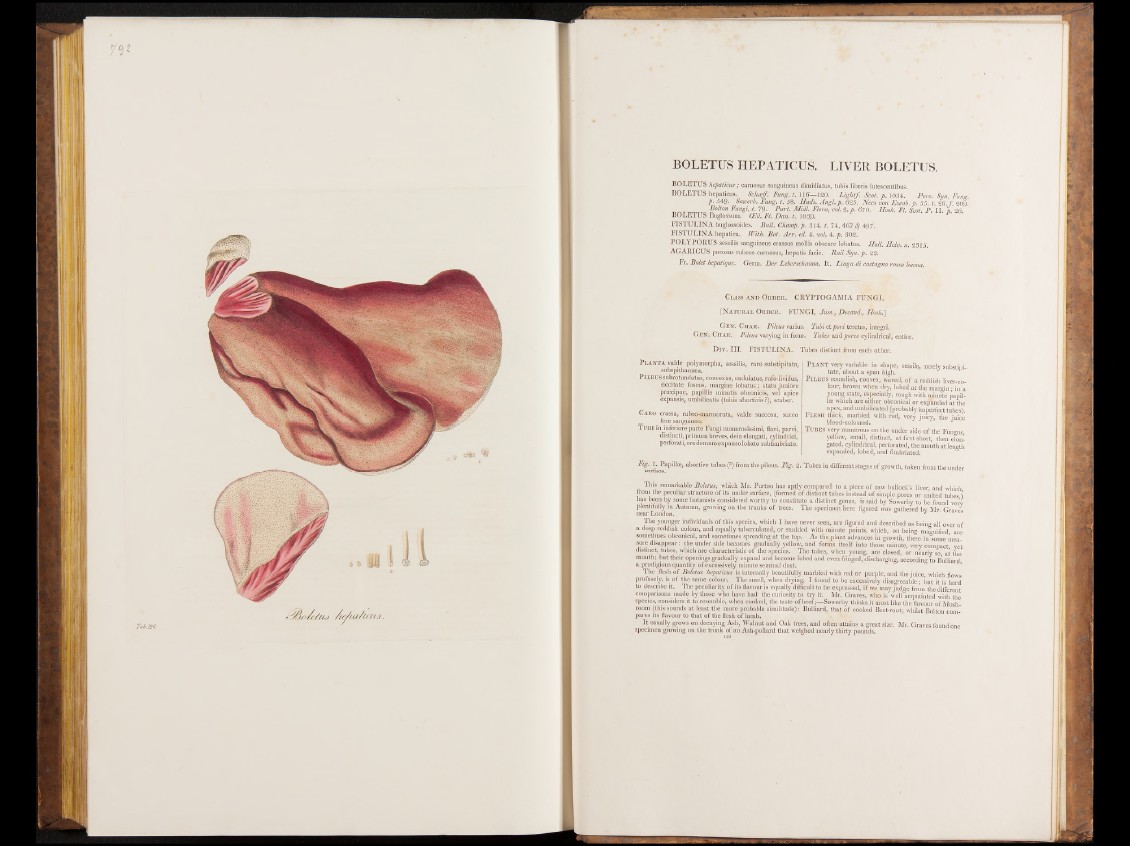
BOLETUS HEPATICUS. LIVER BOLETUS.
BOLETUS hepaticus ; cârnosus sanguineus dimidiatus, tubis liberis lutescentibus.
BOLETUS hepaticus. Schæff. F u n g .t. 116—120. L ig h t/. Scot. p . 1034. Pers.
p . 549. Sowerb. Fung. t. 58. Huds. Angl. p. 625. Nees von Esenb. p. 55. t
Bolton Fungi, t. 79■ Purt. Midi. Flora, vol. 2. p. 670. Hook. FI. Scot P .
BOLETUS Buglossum. (Ed. FI. Dan. t. 1039.
F IS TU L IN A buglossoides. Bull. Champ, p . 314. t. 74, 467 $ 497.
F IS TU L IN A hepatica. With. Bot. A r r . ed. 4. vol. 4. p. 302.
PO LYPORUS sessilis sanguineus crassus mollis obscure lobatus. Hall. Helv. n. 2315.
AGARICUS porosus rubens camosus, hepatis facie. R ail Syn. p . 23.
Fr. Bolet hépatique. Germ. Der Leberschamm. I t. Linga di castagno rossa buona.
Syn. Fung.
. 2 6 . / 209.
I I . p . 26.
Class and Order.
[N atural Order.
Gen . Char. Pileus varius.
CRYPTOGAMIA FU N G I.
FU N G I, Juss., Dccand., Hook.]
Gen . Char. Pileus varying in form.
D iv . I I I . F ISTU L IN A .
Planta valde polymorpha, sessilis, raro substipitata,
subspitbamtea.
Pileus subrotundatus, convexus, undulatus, rufo-lividus,
siccitate fuscus, margine lobatus; statu juniore
prfficipue, papillis minutis obconicis, vel apice
expansis, umbilicatis (tubis abortivis ?), scaber.
Caro crassa, rubro-marmbrata, valde succosa, succo
fere sanguined.
T ubi in inferiore parte Fungi numerosissimi, flavi, parvi,
distinct], primum breves, dein elongati, cylindrici,
perforati, ore demum expansolobato subfimbriato.
Fig. 1. Papillee, abortive tubes (?) from the pileus. Fig. 2
Tubi et pori teretes, integri.
Tubes and pores cylindrical, entire.
Tubes distinct from each other.
Plant very variable in shape, sessile, rarely substipi-
tate, about a span high.
Pile os roundish, convex, waved, o f a reddish liver-colour,
brown when dry, Iobed at the margin; in a
young state, especially, rough with minute papilla]
which are either obconical or expanded at the
apex, and umbilicated (probably imperfect tubes).
Flesh thick, marbled with red, very juicy, the juice
blood-coloured.
Tubes very numerous on the under side of the Fungus,
yellow, small, distinct, at first short, then elongated,
cylindrical, perforated, the mouth a t length
expanded, Iobed, and fimbriated.
. Tubes in different stages o f growth, taken from the under
This remarkable Boletus, which Mr. Purton has aptly compared to a piece of raw bullock’s liver and which
from the peculiar structure of its under surface, (formed of distinct tubes instead o f simple pores or united tubes )
has been by some botanists considered worthy to constitute a distinct genus, is said by Sowerby to be found very
plentifully m Autumn, growing on the trunks of trees. The specimen here figured was gathered bv Mr Graves
near London. 17
The younger individuals of this species, which I have never seen, are figured and described as being all over of
a deep reddish colour, and equally tuberculated, or studded with minute points, which, on bein» magnified are
sometimes obconical, and sometimes spreading at the top. As the plant advances in growth, these in some measure
disappear : the under side becomes gradually yellow, and forms itself into those minute, very compact yet
distinct, tubes, which are characteristic of the species. The tubes, when young, are closed, or nearly so a t the
mouth ; but their openings gradually expand and become Iobed and even fringed, discharging, according to Bulliard
a prodigious quantity of excessively minute seminal dust.
The flesh of Boletus hepaticus is internally beautifully marbled with red or purple, and the juice, which flows
profusely, is of the same colour. The smell, when drying, I found to be excessively disagreeable; but it is hard
to describe it. The peculiarity of its flavour is equally difficult to be expressed, if we may judge from the different
comparisons made by those who have had the curiosity to try it. Mr. Graves, who is well acquainted with the
species, considers it to resemble, when cooked, the taste of beef;— Sowerby thinks it most like the flavour of Mushroom
(this sounds a t least the more probable similitude): Bulliard, that o f cooked Beet-root; whilst Bolton compares
its flavour to that of the flesh of lamb.,
I t usually grows on decaying Ash, Walnut and Oak trees, and often attains a great size. Mr. Graves found one
specimen growing on the trunk of an Ash-pollard that weighed nearly thirty pounds.